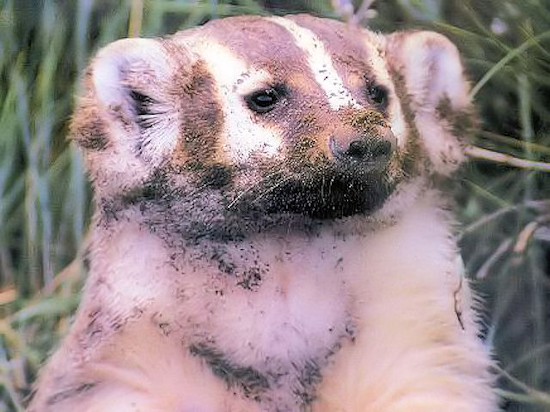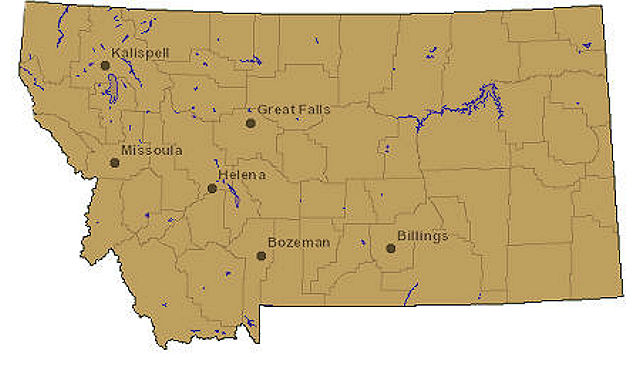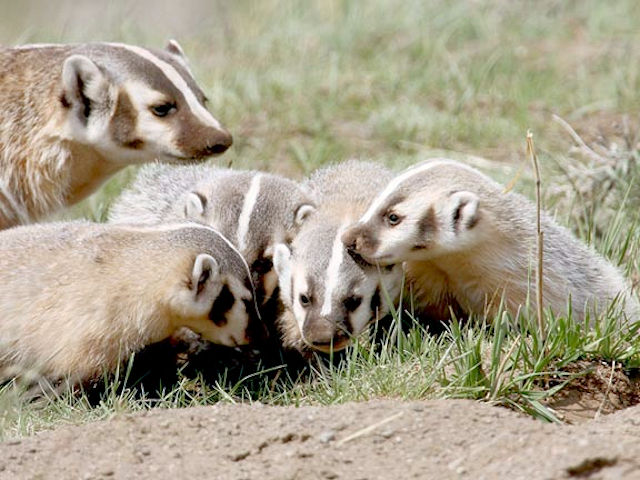Badger

Taxidea taxus
Order:
Carnivora
Family:
Mustelidae
Status: Sporadic and limited importance to the fur market.
Abundant: Unprotected predator
Identifying Characteristics: Remarkably adapted morphologically for burrowing and feeding on burrowing prey. A stout, compact, heavy-bodied animal built low to the ground, with partially webbed toes and long claws to aid in digging. It is the only true fossorial carnivore in North America and thus unique in appearance.
A yellowish-gray mammal with a white stripe over the top of its head, white cheeks, black feet, and a black spot in front of each ear. The belly and short tail are yellowish. Pelage is composed of underfur with longer guard hairs. Because of their shaggy coat and short stature, badgers appear to flow along the ground. Total length: 22 to 28 inches. Weight: 13 to 25 pounds.
Habitat: Prefers open grasslands, shrub/grasslands, and deserts. Non-forested habitats with soils suitable for burrowing and support of fossorial prey are favored.
Food Habits: Very efficient predator of fossorial and semifossorial prey. However, an opportunistic feeder and supplements its diet with a variety of mammals, birds, eggs, reptiles, amphibians, and plants.
Life History: Mostly nocturnal, but also active during the day. Efficient digger, digs out small rodents. Dens in burrows of its own making. Breeds from May through August; delayed implantation; young born February to May; litter size ranges from one to four.
Badgers are well known for their digging habits and nasty dispositions when they are forced to defend themselves. An important predator of gophers and prairie dogs, they favor prairies, open farmlands and deserts. Numerous excavations make badgers unpopular with some farmers and ranchers. Viewed with either affection or disgust, badgers are expanding their ranges eastwardly.
 Description
Description
Adult badgers measure 30 to 35 inches
in length, including a short and well furred
tail of 5 or 6 inches. Body shapes are
wide, giving a flat backed appearance.
Many adult badgers weigh 12 to 16 pounds,
although weights might increase to over 20
pounds in the late fall as they store up layers
of fat to sustain them during periods of cold
weather and deep snow.
Colors are mostly grey, with a grizzled effect due to long guard hairs that have a black band ending in a white tip. Underfur is either a light tan, or a creamy white. A white stripe from the nose leads between the eyes and back over the head of the badger, ending between the shoulders.
Ears are set low along the sides of the head. Lower legs and feet are black in color. There are five toes on each foot and four of the toes on the front feet have exceptionally long claws of up 11/2 to 1 3/4 inches in length.
Badgers have 34 teeth, including four sharply pointed canine teeth. All badgers have a pair of musk producing glands near the anus as well as two skin glands located on the bellies.
 Reproduction
Reproduction
Badgers mate in August or September.
Delayed implantation of fertilized eggs occurs,
and the development of the litter begins in late
February when the eggs attach to the uterus of
the female. The actual development time is
approximately 9 weeks before 2 to 7 young are
born. Although the female has 8 teats,
litter sizes tend to be small, and a litter size
of 3 is common. Females care for the
litter by themselves. Juveniles disperse
in late summer to begin solitary lifestyles.
Habits
Badgers are territorial throughout most
of the year. Most territories are about 3
or 4 square miles. The size of the
territory might vary somewhat due to the
availability of rodents, a preferred food.
It seems as if territories are not defended
against other badgers, or territories overlap
regularly in good habitats. Habitats
with sandy or porous soils are preferred.
Badgers frequent wooded areas when soils are
suitable for digging. Other than the
dispersal of juveniles, badgers do not seem to
emigrate. Typically walking from place to
place, they can trot or bound along at a gallop
when they chose to.
Badgers have excellent senses of hearing and smell. Both serve in locating food species, which are usually rodents in underground dens. Vision is good, and enables a badger to recognize danger at a distance. Badgers have been known to plug the exit holes of prey species before the badger tunnels underground to capture the prey. The long claws serve to loosen the soil and pass it backwards where the hind feet kick the soil out behind the digging animal. This dirt is often kicked backwards 6 or 8 feet in an almost continuous arc by a badger digging in earnest. Badgers close their eyes as they dig underground. They rely upon smell and hearing to continue digging towards the prey.
Even though Badgers have relatively small territory zones, a number of dens are used regularly over different parts of the territory. These underground dens are quite often elaborate. Most tunnels are 6 to 8 feet deep and 20 to 30 feet long to the main chamber which is elevated to discourage flooding. A smaller chamber s also dug underground to serve as a toilet area, and many dens have several entrance holes. Dens that have been used for generations by badgers may have as many as 30 to 40 exits, and tunnels as deep as 15 feet. Bedding grass and leaves are sometimes removed from the den chamber for airing out by a den entrance, after which it is taken back down into the chamber for reuse.
Some badgers have demonstrated that they will tolerate a fox or coyote sharing the same den. In 1871, a lost Canadian boy shared a den with a badger, which at first tried to drive him away, and then appeared to adopt him by bringing him food.
General
Badgers are determined fighters when
they are threatened. Their loose fitting
skin prevents the from being held securely by
another animal.
Badgers do not hibernate, but they do sleep for extended periods of time in northern states during extended periods of cold weather and deep snow. Wintering dens can sometimes be found in woodlands, where the frost does not penetrate as deeply. They can stay underground for weeks at a time, but they come out to hunt occasionally as they do not store food.
Other than rodents, badgers also eat skunks, snakes, birds and their eggs, worms, insects, berries and carrion. Rattlesnakes are eaten when a available but the badgers do not eat the rattlesnake head. Carrion is probably an important winter food when the frozen ground is difficult or impossible to dig in.
The condition of it's claws are important to a badger. The species sharpens their long claws by scratching on trees or posts.
A badger is considered to be old at 12 years of age.